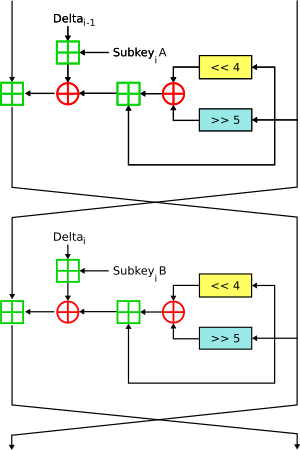This article includes a list of general references, but it lacks sufficient corresponding inline citations. (September 2015) |
 Two Feistel rounds (one cycle) of XTEA | |
| General | |
|---|---|
| Designers | Roger Needham, David Wheeler |
| First published | 1997 |
| Derived from | TEA |
| Successors | Corrected Block TEA |
| Cipher detail | |
| Key sizes | 128 bits |
| Block sizes | 64 bits |
| Structure | Feistel cipher |
| Rounds | variable; recommended 64 Feistel rounds (32 cycles) |
| Best public cryptanalysis | |
| A related-key rectangle attack on 36 rounds of XTEA (Lu, 2009)[vague] | |
In cryptography, XTEA (eXtended TEA) is a block cipher designed to correct weaknesses in TEA. The cipher's designers were David Wheeler and Roger Needham of the Cambridge Computer Laboratory, and the algorithm was presented in an unpublished technical report in 1997 (Needham and Wheeler, 1997). It is not subject to any patents.[1]
Like TEA, XTEA is a 64-bit block Feistel cipher with a 128-bit key and a suggested 64 rounds. Several differences from TEA are apparent, including a somewhat more complex key-schedule and a rearrangement of the shifts, XORs, and additions.
- ^ Roger M. Needham; David J. Wheeler (October 1997). Tea extensions (PDF). Computer Laboratory, University of Cambridge (Technical report).